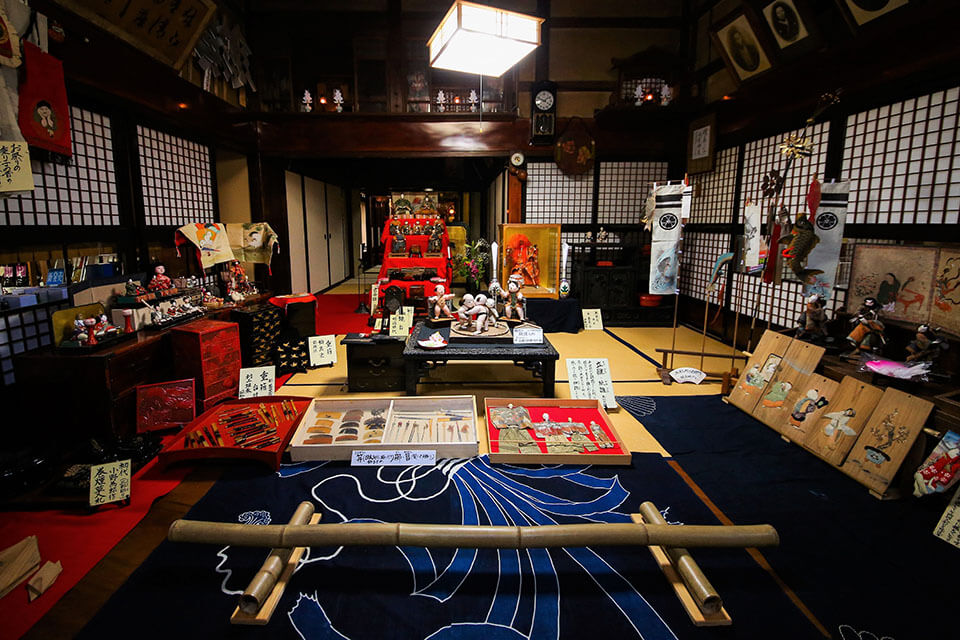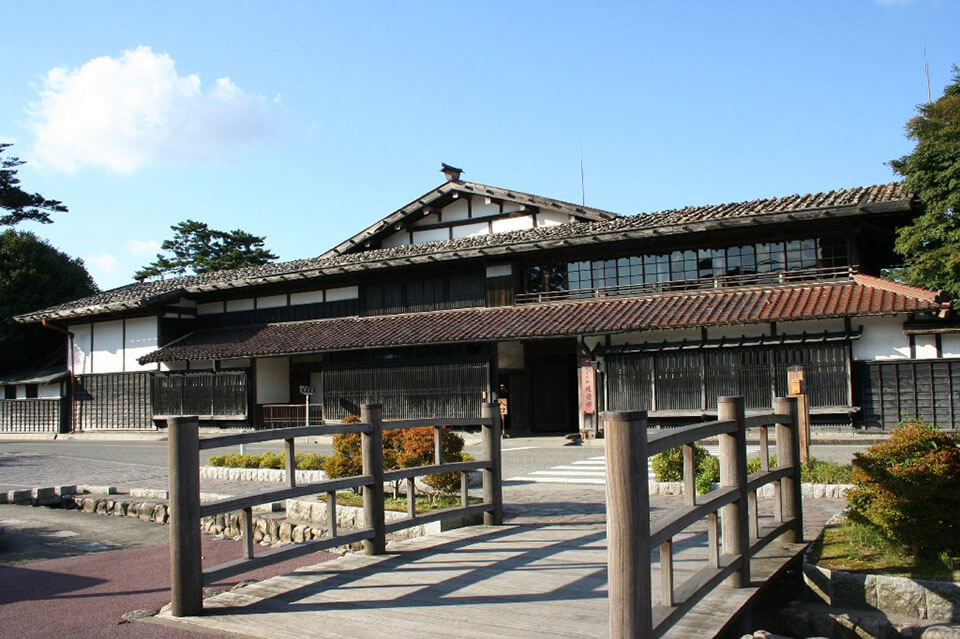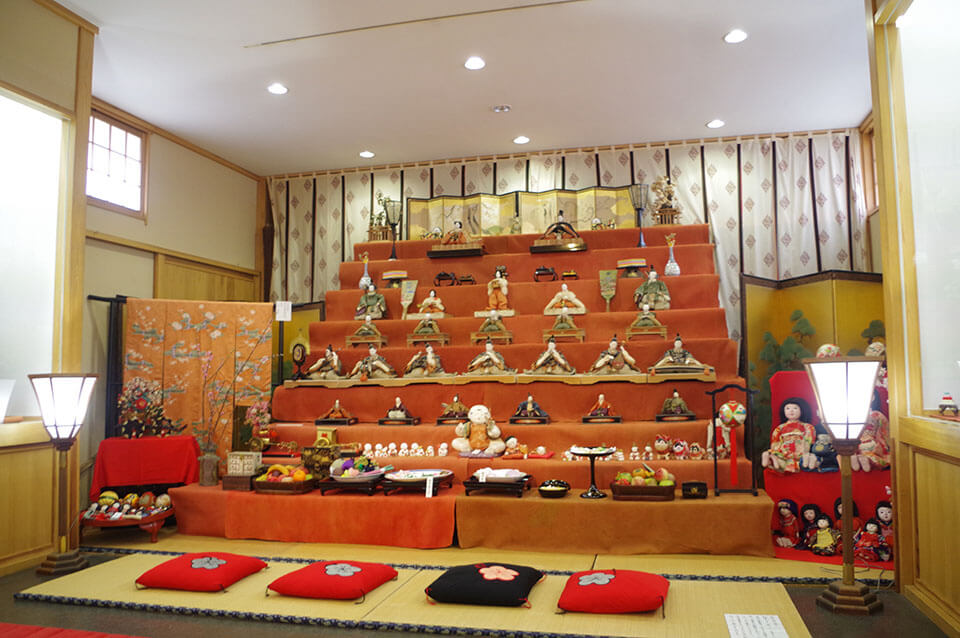This is a four-day model course that lets you take your time to enjoy Japanese hina dolls in Niigata and Yamagata prefectures to your heart’s content. In the castle town of Murakami city, Niigata prefecture, you’ll get to walk through the streets and see the dolls passed down by families through generations. In Sekikawa village, you’ll see clay dolls that have been made since long ago, and in Tsuruoka city, Yamagata prefecture, you’ll see hina dolls transported from Edo through the policy of alternate attendance that required feudal lords to alternate living in their domains and in the capital of Edo. In Shonai town, apart from a hina doll tour, you’ll also be able to enjoy an old shoyu (soy sauce) shop, as well as onsens (hot springs). In Yuza town, do take a look at the hina doll decorations in the former Aoyama main residence, and stop by a cafe in an old Japanese-style house.
Itinerary
nights
days
Day One
01
Townhouse doll walking tour in the castle town of Murakami
In the former castle town of Murakami, many different types of dolls remain today, including the hina dolls that families have passed down through generations.


About 70 houses take part in the doll walking tour, which is held from March to early April every year. You will be able to see the dolls in each house.
Every year, the Murakami Castle Town Hina Doll Exhibition is also held at the Oshagiri Hall, the Wakabayashi family residence, and the Murakami Museum of History and Culture. Hina dolls connected to the Naito family, the former feudal lords of Murakami, as well as to old and merchant families in the city are displayed here.
Access
About 10 minutes’ walk from Murakami Station on the JR Uetsu Main Line


Fujimien
Address: 4-19 Nagaimachi, Murakami, Niigata
Phone number: 0254-52-2716
Access: about 17 minutes’ walk from Murakami Station
Opening hours:
8:00 – 19:00 (Fujimien)
11:00 – 17:00 (Last order at 16:30) (Kaneei Tea Room)
Closed on: Wednesday (Kaneei Tea Room)
02
Fujimien
This is an old specialist tea shop that has been operating since 1868, the first year of the Meiji era. The shop includes the Kaneei Tea Room, a cafe that specializes in Japanese tea, where you can enjoy Murakami’s specialty Murakami tea; Yukiguni black tea; as well as gelato.
If you’re going to enjoy the doll walking tour, why not take a break with delicious tea?

03
Watanabe residence
Built in 1817, this was the mansion of wealthy merchants and farmers. It has been nationally designated as an important cultural property.


During the Doll Festival (according to the old Japanese calendar), the kokin-bina (a hina doll style) and hina dolls that the ninth-generation head of the Watanabe family sought for his eldest daughter’s first festival are displayed here, as well as the clay dolls that ordinary families in Sekikawa village displayed during this time.
Admission fee:
600 yen for adults; 250 yen for children
04
Kousagi no Yado (The Inn of Kousagi): Arakawaso
This is an inn whose motif is the auspicious rabbit, the guardian deity of the sacred mountain of Mt. Kousagi in Sekikawa village. The entire building is floored with tatami mats, so you’ll be able to relax in a calm space. The bath made of ancient Japanese cypress, the baths where you can reserve time for private bathing, as well as the Japanese-style sets of dishes that make ample use of local ingredients are also appealing.

Day Two
In the Shonai area in Yamagata prefecture, you can visit the Shonai Hina Doll Road, where hina dolls with history behind them that have been cherished and passed down through old families are displayed to the public.
01
Shonai Shrine
The shrine was built in 1877 by the people throughout Shonai in the old citadel site of Tsurugaoka Castle, in adoration of the successive generations of feudal lords from the Sakai family, who were the feudal lords of Shonai.


In the sanctuary within the shrine, about 100 hina dolls presented by old families from the Edo to the Showa periods are displayed, as well as hina doll accessories.
02
Chido Museum
This is a museum set up in the residence for official business of the Sakai family, the former feudal lords of Shonai; it allows you to learn about the history and culture of Tsuruoka. Many precious historic buildings have been reconstructed and preserved here, such as multi-story private houses; the old Tsuruoka police station building; and the former Nishitagawa district office, which has been nationally designated as an important cultural property. The hidden hall includes yusoku-bina dolls (a style of hina doll dressed in courtly attire) from the Sakai family as well as hina dolls from old families, allowing you to enjoy the elegant hina dolls characteristic of the families of feudal lords.


03
Heishindo
The Kazama family were purveyors to the government of Shonai Domain and the most prominent family of wealthy merchants in Tsuruoka. Heishindo was built in 1896 by Kouemon, the seventh-generation head of the Kazama family, in the site of a former samurai residence, in order to serve as a dwelling as well as a base for the family’s business activities; it is a precious piece of historical heritage that conveys traces of the lives of wealthy merchants in the past to people in the present, and has been nationally designated as an important cultural property. It has many items on display, including hina decorations made by Eitokusai II and purchased by the older sister of the ninth-generation family head towards the end of the Taisho era; keshi-bina dolls (a style of miniature hina doll) bought in Taipei, where that family head’s mother was born; and hina dolls and sagemon hanging decorations from the collection of Ms. Eiko Abe, a researcher on hina dolls.
04
Umetsu Confectionery Shop
This is a shop for inexpensive sweets that has been operating since the Edo period. Just like when it was founded, it does not use any machinery, and lets customers feel the warmth of handmade sweets as well as flavors dating from the Edo period.


In the Shonai area, there is a custom of offering vividly colored sweets to hina dolls. Umetsu Confectionery Shop sells doll sweets shaped like vegetables and fruits, as well as like auspicious sea breams and shrimps, for this purpose.
05
Yutagawa Onsen
This is a tranquil hot-spring village that has been open for 1,300 years, and which has been called the inner parlor of Tsuruoka since long ago.

In the 100-year-old former Shirahata residence, which belonged to an old family, hina dolls from the Edo and Meiji periods as well as Takasago dolls that are 70cm tall are displayed to the public once a year.

06
Yudonoan Cafe
Cafe Fukumori is operated in one corner of Yudonoan, the traditional Japanese inn attached to Yutagawa Onsen.


You’ll be able to enjoy specially made hotcakes topped with honey or cream produced in Yamagata, as well as cream soda with seasonal fruits.
Day Three
01
Shonai Town New Industry Innovation Center Classe
This is a tourism base facility that made good use of rice warehouses in front of JR Amarume Station. Apart from an information center about Shonai town, it includes restaurants, Cafe Amarume-sei Pan (Amarume Bread), and Nandemo Bazaar Addeba, allowing you to enjoy shopping and food.


Apart from a tour of the cellars, the tasteful four-season garden is also worth seeing.
02
Hanabusa Shoyu
This is an old shoyu (soy sauce) shop that was founded in 1823. It produces and sells shoyu, miso, as well as Shoyu no Mi (a condiment made of shoyu fermenting mash). It also sells its products in-shop, making them perfect as a souvenir that brings you the nostalgic flavor of Shonai. Hina dolls are also displayed there during this period, so why not appreciate them while shopping?


Clay hina dolls were affordable and popular among the common people of the Tohoku region. They are simple and have a unique charm, and each one lets you feel its historical background as well as the wishes of the parents who bought it.
03
Kamenoo no Sato Museum
This museum displays old farming implements and folk articles, as well as the achievements of seven wetland rice growers, including Kameji Abe, who created the Kamenoo variety of rice, which is famous as the source of high-quality rice throughout the country. It also displays 1,000 clay hina dolls, as well as hina dolls that have been cherished for generations in old families.


04
Shonai Town Gallery Onsen Machiyu
This is a new-style onsen facility that combines an onsen with a gallery. The gallery space has works of art and products on display. The bathrooms and open-air baths are arranged to surround the courtyard, creating a space where you can spend time relaxing.
Access: Three minutes by car from Amarume Station
URL Click here for details
05
Maiko Teahouse Somaro/Takehisa Yumeji Art Museum
Somaro is a nationally registered cultural property that was created when the restaurant Somaya, which was formerly patronized by cargo ship owners and merchants, was remodeled. The first floor contains a teahouse where visitors can relax, while the reception hall on the second floor is a theater where you can enjoy your meal along with the dances of Sakata maiko (apprentice geisha). (Lunch requires a reservation)


From March 1 onwards when the Sakata Hina Doll Road is open, the hina dolls that decorated the tatami room of Kagaya, the Sakata wholesale rice dealer in the NHK morning serial TV drama “Oshin” (1983), are on display.
Opening hours: 10 a.m. to 5 p.m. (last entry at 4:30 p.m.)
Closed on: Wednesday (also closed during the Bon Festival and at the start and end of the year)
Access: Five minutes by car from JR Sakata Station
06
Sanno Club
Sanno Club is one of the tourist facilities that represent Sakata, and is also a nationally registered tangible cultural property. It includes an exhibition area that focuses on the period in which Sakata flourished from the presence of cargo ships, as well as a permanent exhibition room for kasafuku. Kasafuku are one of the three great hanging ornaments of Japan, and you will also be able to experience making kasafuku here (booking required).
There is a planned exhibition that opens together with the Sakata Hina Doll Road. Large and small kasafuku are displayed there, gorgeously decorating the reception hall.
Opening hours: 9 a.m. to 5 p.m. (last entry at 4:30 p.m.)
Closed on: no days (March to November); Tuesday (December to February); the beginning and end of the year
Access: five minutes by car from JR Sakata Station

Day Four
01
Sankyo Warehouses
Sankyo Warehouses
These are warehouses for the storage of rice that were built in 1893. The view of 12 warehouses along with rows of Japanese zelkova is famous as a symbol of the rice-producing region of Shonai. At night, the area is lit up, and the white walls of the warehouses stand out in a wondrous way.
The tourism product center “Sakata Yume no Kura” is housed in a remodeled section of the warehouses. There, you can purchase souvenirs, such as local specialties of Sakata and local sake.
From late February to March, hina dolls that were created in the late Edo period and that have been cherished and passed down over time are displayed to the public here. Including momotose-bina dolls (a style of “hundred-year-old” hina dolls with white hair) and large kokin-bina dolls that are over 40cm tall, the elaborate, luxurious hina dolls are worth seeing.

■ Sakata tourism product center “Yume no Kura”
Opening hours: 9 a.m. to 6 p.m. (5 p.m. from December to February)
Closed on: January 1
Access: five minutes by car from JR Sakata Station
■ Illumination of the Sankyo Warehouses
Time: 6 p.m. to 10 p.m.
02
Former Aoyama main residence
Tomekichi Aoyama was born into a poor fishing family in Aotsuka, Yuza town. He achieved huge success in herring fishing in Hokkaido and used that wealth to build this residence. In 2000, the building was evaluated to have preserved the characteristic architectural style of the Meiji period well, and was nationally designated as an important cultural property.


From late February to early April, you can see the kokin-bina dolls and hina doll accessories passed down through the old Aoyama family here.
Opening hours:
9:30 a.m. to 4:30 p.m. (last entry at 4 p.m.)
Closed on: Monday
Access:
20 minutes by car from JR Sakata Station
03
Wadaya
This is a cafe built in a repaired 69-year-old modern old Japanese-style house. It is popular for its tatami-matted rooms, which let you comfortably relax. Its signature dish is its oyaki (a kind of Japanese dumpling), made with Yuza-produced ingredients; the food can be taken away.


Closed on:
Thursday and Friday (closed in winter from January 16 to February 28)
Opening hours:
11:00 – 18:00 (last order at 17:30)
TEL: 0234-31-8650